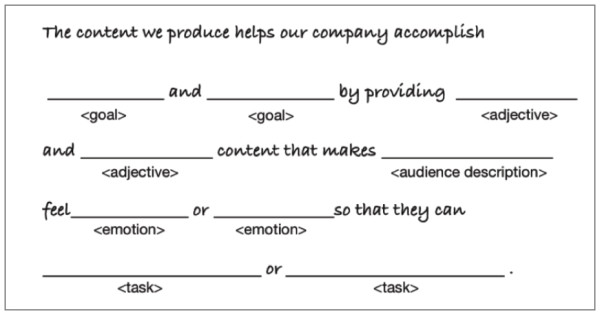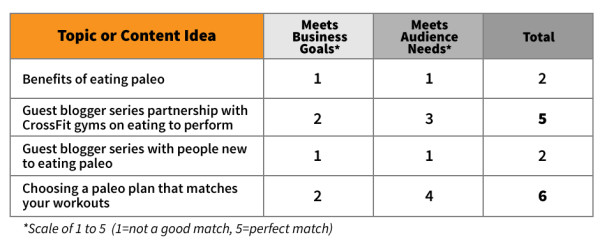
A lot of my clients and workshop attendees tell me that they don’t have a clear idea of what they hope to accomplish with their content. Or if they do have a clear idea, it’s not written down. Sound familiar?
That’s why I spend a lot of time helping content professionals put their strategies into words. One of the most powerful things we do together is boil down their words to a single statement: a core content strategy statement.
One of the most powerful things we can do is boil down words to a core #contentstrategy statement. Click To TweetWhen everyone on your content team works from the same core content strategy statement, your organization has the best possible chance of getting the results you seek.
I’m not talking about an editorial mission statement or vision statement. Those types of super-high-level statements typically get crafted once and apply to everything everyone does from then on. A core content strategy statement is more flexible and more performance-oriented, and you can create as many as you want. You might create one for a given content marketing initiative or for a specific audience. You can make it broad or narrow.
I introduced the idea of the core content strategy statement in Why You Need Content Strategy Before Editorial Planning, which I ended with a promise to follow up with another article. This is it. Explore the three things you can do to keep your content ideas on-strategy every time:
- Create a core content strategy statement.
- Use the core content strategy statement to choose topics.
- Add the core content strategy statement to your editorial checklist.
1. Create a core content strategy statement
One smart – and fun – way to craft a core content strategy statement that will serve you well is to involve stakeholders in a fill-in-the-blank activity. I recommend using a Mad Libs®–type exercise. (Hat tip to content strategy consultant Sara Wachter-Boettcher for this idea.) Here’s a template that I use in my workshops.

Fill-in template for a core content strategy statement
This template includes the three key components of any content strategy:
- Business goals
- Target audience
- Audience needs
If you want to create content that performs, your team needs to get clear on all three components for whatever kind of content you’re focusing on.
Here’s a completed example based on the business goals, target audience, and audience needs that I described for the company Origin Meals.

Example of core content strategy statement
Click to enlarge
For your stakeholder meeting, print at least one template per participant. Ask everyone to fill it out. Next, discuss all responses as a group. From there, finesse the responses into a single statement. Get all your stakeholders to agree to your core content strategy statement so that your team has a solid basis for brainstorming content ideas.
Content Strategy 101 for Content Marketers: Your Questions Answered
2. Use the core content strategy statement to choose topics
Use your approved core content strategy statement as a basis for brainstorming content ideas and choosing which topics to say yes to.
Bring together stakeholders to evaluate content ideas as a group. To make these sessions as productive as possible, I recommend using a content decision-making matrix. I use a matrix like the one shown, which enables teams to evaluate each idea based on how well it meets the stated business goals and audience needs.
Template for content decision-making matrix
Click to enlarge
Show the matrix on a screen or whiteboard. Go through each topic or content idea as a group. Through discussion, have stakeholders agree to a score on a scale of 1-5 for each idea. A typical matrix looks something like this:
Example content decision-making matrix with scores
Click to enlarge
Generally, discard ideas with a total score of 3 or lower; they don’t align with your core content strategy statement, so they’re unlikely to perform well. Consider the total scores as one factor in deciding which ideas to pursue. Consider other factors, too, like the amount of time and money needed to execute the idea.
3. Add the core content strategy statement to your editorial checklist
Share your core content strategy statement with content producers and reviewers, and ask them to use it to guide their efforts. I recommend that you add the core content strategy statement to an editorial checklist to help keep the strategy top of mind. Some teams use this checklist as a tool for reviewers and editors to use to provide feedback to content creators. Include items in your list that address business goals, user needs, main messages, and calls to action.
Here’s an example of the kind of checklist items I have in mind. The core content strategy statement is in bold.
- Supports the Origin Meals goal of increasing new and recurring orders by providing motivating and informative content that makes busy single athletes feel excited or confident so that they can fit paleo eating into their lifestyles
- Addresses an information need or curiosity that our audience is likely to have.
- Contains a prominent and appropriate call to action.
- Make your checklist as detailed as needed to serve your team. For experienced writers, a short list may suffice. For people who haven’t done much writing for the web, you may want to add best practices like these:
- Each paragraph expresses one key idea only.
- Subheads and bullet points make the content more scannable for readers who skim.
- The title and subheads clearly convey the main message.
- The content is free of potentially confusing jargon, phrases that might not make sense to a portion of the target audience, and overly clever language.
- Sentence and paragraph lengths are varied.
- Calls to action start with an imperative verb.
- Linked text communicates what users will find after they click.
Whatever kind of checklist works for you, I think you’ll find that putting the appropriate core content strategy statement at the top keeps your team focused on the right strategic goals, making it more likely that your content will perform well time after time.
How to Write Content That Engages Mobile Readers
Summary
I hope that the tools I’ve described – the fill-in template, the content decision-making matrix, and the editorial checklist – will help your team discover the value of defining a core content strategy statement and using it as a guide throughout your content development processes. I predict that when you do, you’ll spend less time on low-performing content and more time on content that performs well for your business and your customers. I’d love to hear whether this prediction comes true. Please let me know in a comment.
How to Structure Your Business Blog Posts to Maximize Conversions
Sign up for our Content Strategy for Marketers newsletter, featuring exclusive insights from CMI’s Chief Strategy Officer, Robert Rose. If you are like many other marketers we meet, you’ll come to look forward to his weekly thoughts.
Cover image by Joseph Kalinowski/Content Marketing Institute



